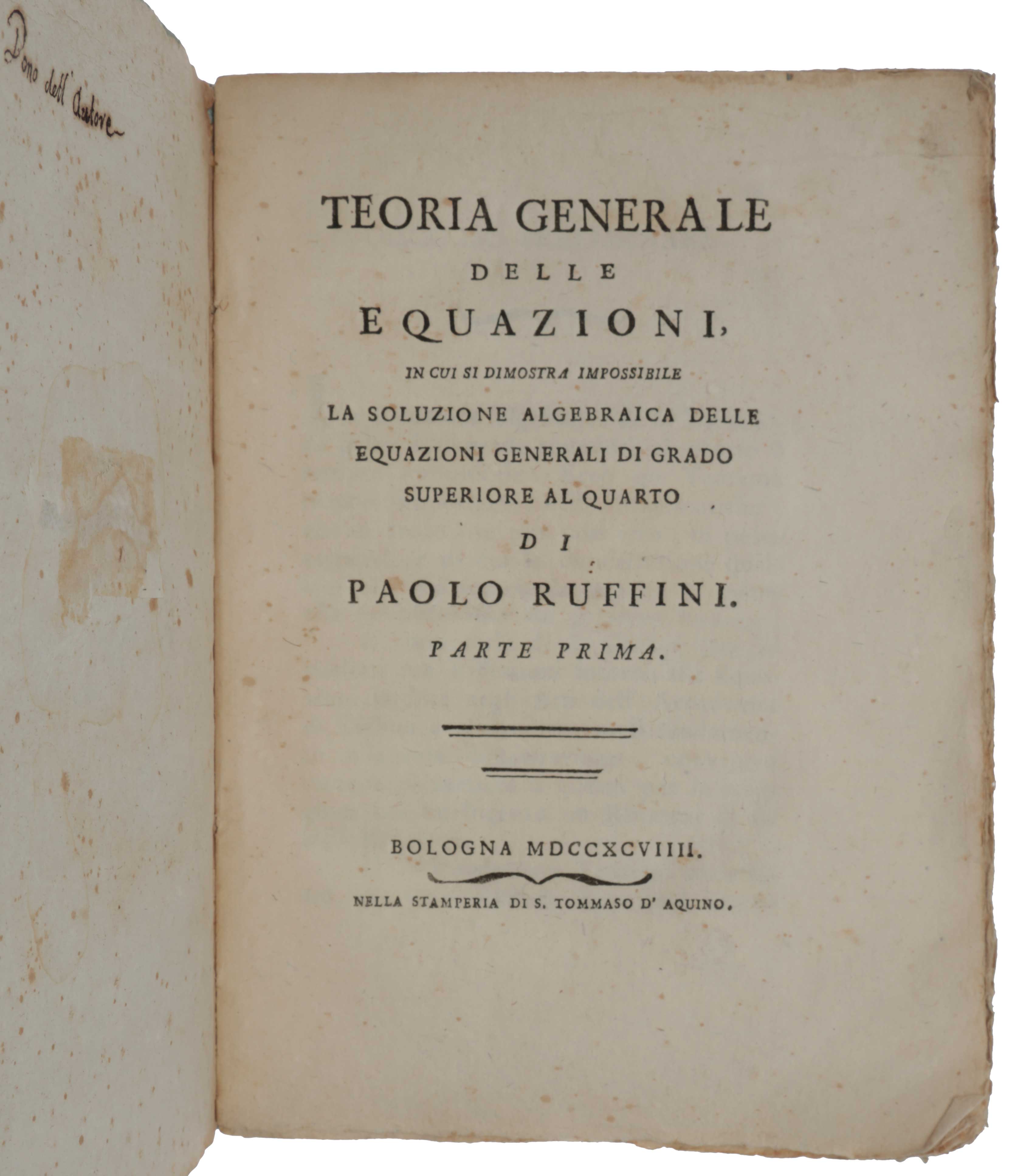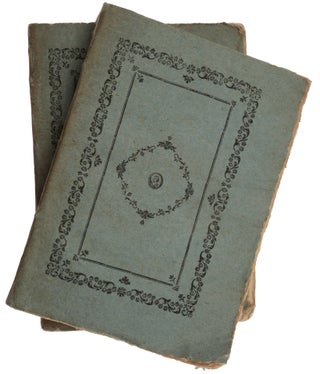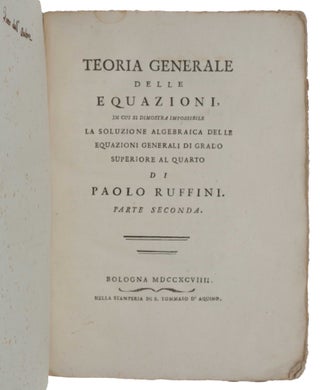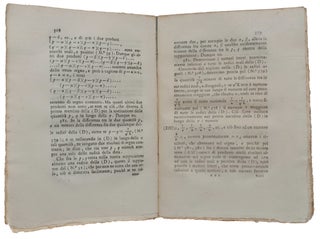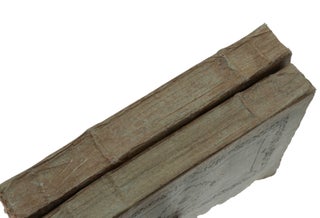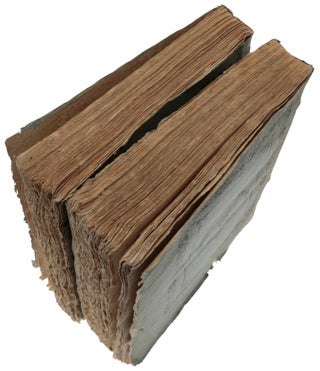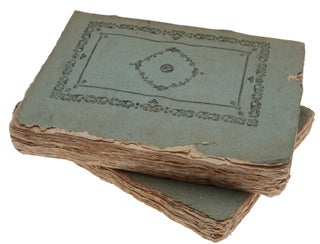Teoria Generale delle Equazioni, in cui si dimostra impossibile la soluzione algebraica dell equazioni generali di grado superiore al quarto.
Bologne: Stamperia di S. Tommaso d’Aquino, 1799. First edition, very rare, of the first statement and proof that the general equation of degree five or more cannot be solved algebraically. This is a remarkable author’s presentation copy, uncut in the publisher’s printed wrappers. “One of the most fascinating results in the realm of algebra – indeed in all of mathematics – is the theorem that the general polynomial of degree ≥ 5 is not solvable by radicals. Its discovery at the very end of the 18th century went counter to the belief and expectations of mathematical scholars; it came as a great surprise and was naturally met with scepticism … this revolutionary idea was not accepted without a great deal of resistance” (Ayoub, p. 253). An exception was the great French mathematician Augustin-Louis Cauchy, who wrote to Ruffini in 1821: “Your memoir on the general resolution of equations is a work that has always seemed to me worthy of the attention of mathematicians and one that, in my opinion, demonstrates completely the impossibility of solving algebraically equations of higher than the fourth degree.” In Ruffini’s arguments one can now see the beginnings of modern group theory. “Ruffini’s methods began with the relations that Lagrange had discovered between solutions of third- and fourth-degree equations and permutations of three and four elements, and Ruffini’s development of this starting point contributed effectively to the transition from classical to abstract algebra and to the theory of permutation groups. This theory is distinguished from classical algebra by its greater generality: it operates not with numbers or figures, as in traditional mathematics, but with indefinite entities, on which logical operations are performed” (DSB). “Ruffini is the first to introduce the notion of the order of an element, conjugacy, the cycle decomposition of elements of permutation groups and the notions of primitive and imprimitive. He proved some remarkable theorems [in group theory]” (MacTutor). Ruffini’s proof did, in fact, have a gap which was filled in 1824 by Niels Henrik Abel (although Abel’s proof also had a gap), and the insolvability of quintic equations is now known as the Ruffini-Abel theorem. This is a very rare book on the market in any form (ABPC/RBH list only a single copy) and we have never before seen nor heard of a copy in publisher’s wrappers, or a presentation copy. Provenance: Author’s presentation copy (“dono dell’autore” written on the front fly-leaf of both volumes). The method of solving quadratic equations was known to the Baghdad mathematician and astronomer Al-Khwarizmi (c. 780-850), and the formula involving square roots is now taught to every student in high school. Similar formulas for solving cubic and quartic equations were not found until the 16th century, by Scipione del Ferro (1465-1525), Lodovico Ferrari (1522-60), and Niccolo Tartaglia (1506-59), and were first published by Girolamo Cardano (1501-76) in his Ars magna (1545). These formulas expressed the solutions in terms of ‘radicals,’ i.e., expressions involving rational functions (ratios of polynomials) of the coefficients of the equation and their square-, cube-, and higher roots. The search for a similar formula for quintic equations proved fruitless. “For two centuries thereafter, the resolution of the enigma was regarded as one of the most important problems of algebra and occupied the attention of the leading mathematicians of this epoch” (Ayoub, p. 257). The most important work on the problem preceding Ruffini’s was Lagrange’s remarkable memoir ‘Réflexions sur la résolution algébrique des equations, published in the Nouveaux Mémoires de l'Académie Royale des Sciences et Belles-Lettres de Berlin in 1770-71. Katz & Parshall (p. 298) remark that “his introduction of the notion of permutations proved crucial to the ultimate proof that there was no algebraic solution of a fifth-degree polynomial equation,” but Lagrange himself still believed that a solution of the quintic would be found. “He concludes with this statement: ‘There, if I am not mistaken, are the true principles of the resolution of equations, and the most appropriate analysis which leads to solutions; all reduces, as we see, to a type of calculus of combinations by which we find results which we might expect a priori. It would be pertinent to make application to equations of the fifth and higher degrees whose solution is, up to the present, unknown: but this application requires a large number of combinations whose success is, however, very doubtful. We hope to return to this question at another time and we are content here in having given the fundamentals of a theory which appears to us new and general.’ So in spite of past failures in solving the quintic, Lagrange still harbors the hope that a careful analysis of his method will achieve the goal. “Did no one suspect that the solution of the quintic was impossible? Apparently not until 1799 when Ruffini published his book on the theory of equations: ‘General theory of equations in which it is shown that the algebraic solution of the general equation of degree greater than 4 is impossible.’ Parenthetically, we note that in the same year the young Carl Friedrich Gauss (1777-1855) wrote in his dissertation (in which he proved the fundamental theorem of algebra) as follows: ‘After the labors of many geometers left little hope of ever arriving at the resolution of the general equation algebraically, it appears more and more likely that the resolution is impossible and contradictory … Perhaps it will not be so difficult to prove, with all rigor, the impossibility for the fifth degree. I shall set forth my investigations of this at greater length in another place. Here it is enough to say that the general solution of equations understood in this sense [i.e., by radicals] is far from certain and this assumption [i.e., that any equation is solvable by radicals] has no validity at the present time.’ Gauss published nothing more on the subject. “Ruffini begins the introduction of his book as follows: ‘The algebraic solution of general equations of degree greater than 4 is always impossible. Behold a very important theorem which I believe I am able to assert (if I do not err); to present the proof of it is the main reason for publishing this volume. The immortal Lagrange, with his sublime reflections, has provided the basis of my proof’” (Ayoub, pp. 262-3). Ruffini’s proof has been presented in modern dress by Ayoub and cannot be described in detail here. It is now viewed as being correct but with a gap: Ruffini assumed that the radicals that arise in the course of solving the equation are rational functions of the roots, and this assumption requires proof which Ruffini did not provide. This gap was filled 25 years later by Abel (1802-29). Abel’s proof also had a gap, which was filled in 1849 by Leopold Königsberger. In the course of proving his remarkable theorem, Ruffini laid the foundations of group theory, which is now of central importance both in mathematics and in physics (symmetry groups). “Ruffini went beyond the mere recognition that there exists a connection between the solvability of algebraic equations and permutations. In his work the theory of permutations no longer plays the role of a mere computing device but is rather a structural component of solvability theory. “He begins with Lagrange’s program of systematic investigation of permutations from the point of view of their effect on algebraic functions of n variables (a permutation can fix or change such a function) … he prefaces his treatment of fifth- and sixth-degree equations in chapter 13 (‘Riflessioni intorno all soluzione generale delle equazioni’) with a classification of permutations. Apart from a different terminology, the modern permutation group concept appears in this chapter with full clarity. Not only is Ruffini – like Lagrange – concerned with permutations that leave a rational function of the roots invariant; he deals also with the totality of such permutations and their properties. He calls such a set of permutations ‘permutazione.’ Thus Ruffini’s ‘permutazione’ coincides with what Cauchy later called a ‘system of conjugate substitutions’ and Galois called a (permutation) ‘group.’ “It is remarkable that Ruffini used consistently the fact that his ‘permutazione’ is closed, both in connection with the composition of the permutations reproducing the function, and even for the purpose of classifying groups in connection with the question of generators of the ‘permutazione’ … “Ruffini calls the number p of permutations that leave invariant a given function of n roots of an equation the ‘degree of equality’ (grado di uguaglianza). Thus this concept coincides with that of the ‘order’ of a (permutation) group … Ruffini goes on to determine the value of p for all groups that occur in connection with five quantities, the roots of a quintic … In terms of content, this investigation comes down to an (almost) complete determination of all subgroups of the symmetric group S5. In this way Ruffini obtains the main result, formulated in article 275, to the effect that p can never be 15, 30, or 40, that is, that there are no (rational) functions of five quantities that take on 8, 4, or 3 different values when these quantities are permuted in all possible ways. On the basis of this correctly-proved group-theoretic result, Ruffini gives a proof – with some gaps – of the unsolvability of the general quintic in radicals” (Wussing, pp. 82-3). “What reception was accorded this remarkable discovery? In about 1801 Ruffini sent a copy of his ‘Teoria’ to Lagrange but received no response. Shortly thereafter, he wrote: ‘Because of the uncertainty that you may have received my book, I send you another copy. If I have erred in any proof, of if I have said something which I believed new, and which is in reality not new, finally if I have written a useless book, I pray you point it out to me sincerely.’ Lagrange did not reply. “Again in 1802 he wrote to Lagrange: ‘No one has more right … to receive the book which I take the liberty of sending to you … In writing this book, I had principally in mind to give a proof of the impossibility of solving equations of degree higher then 4.’ “Pietro Paoli, professor of analysis at Pisa, wrote in September 1799 with a certain chauvinism: ‘I read with much pleasure your book … and recommended greatly the most important theorem which excludes the possibility of solving equations of degree greater than 4. I rejoice exceedingly with you and with our Italy, which has seen a theory born and perfected and to which other nations have contributed little.’ [It must be remembered that Lagrange was born in Turin and was considered Italian by Italians, though he had come of a French family.] “In 1803, Ruffini published a paper entitled ‘On the solvability of equations of degree greater than 4.’ This was written at the urging of his friend Pietro Abbati (1768-1842). Ruffini wrote: ‘In the present memoir, I shall try to prove the same proposition [insolvability of the quintic] with, I hope, less abstruse reasoning and with complete rigor.’ “To this proof Gian-Francesco Malfatti (1731-1807) raised certain objections which suggest that he did not understand the proof clearly … In 1806 Ruffini published yet another proof with no visible reaction, and in 1813 he published a paper ‘Reflections on the solution of general algebraic equations.’ In the introduction, he expresses his disappointment, if not pique, at the reception accorded his work” (Ayoub, p. 269). “A further impulse to seek appraisal of his work came from a publication by Jean Baptiste Joseph Delambre (1749-1822). This was a report to ‘His Majesty the Emperor and King’ called ‘Historical report on the progress of the mathematical sciences since 1789.’ In it Delambre says ‘Ruffini proposes to prove that it is impossible …’ Ruffini replied: ‘I not only proposed to prove but in reality did prove … and I had in mind presenting the proof to the institute to have it examined and to have the institute pronounce on its validity.’ Ruffini was informed that Lagrange, Legendre and Lacroix had been appointed to a committee to examine his memoir. He was told, however, that ‘if a thing is not of importance, no notice is taken of it and Lagrange himself ‘with his coolness’ found little in it worthy of attention.’ “Ruffini wrote again to Delambre asking about the status of his paper, and noted that the Italian minister had spoken to Lagrange who told the minister that because of the character and manner of expression, he had understood nothing and no longer wished to undertake the reading of his memoir. Ruffini asked Delambre to speak to Lagrange and if the latter did not want to read it, Delambre was to appoint a new board of examiners. “As it turns out, Lagrange, who was old at the time, reported to Gaultier de Claubry that he had read Ruffini’s memoir, had found it good but, since it treated of a difficult matter and since Ruffini had not given sufficient proof of certain things which he claimed, Lagrange did not want to create excitement among the mathematicians of the institute and, therefore, did not want to publish his approval. “Ruffini also sent his memoir to the Royal Society in London. The reply said that the Society itself does not give official approval of any work but reported that those who had read it were quite satisfied that he had proved what he claimed to prove. “His greatest advocate, however, was no less a person than A. L. Cauchy (1789-1857). Cauchy found in Ruffini’s work a veritable gold mine. In the years 1813-1815, Cauchy wrote a lengthy paper on the theory of permutation groups generalizing some of Ruffini’s results. This paper was assessed by a committee of the French Academy of Sciences and this committee mentions Ruffini by name. “Cauchy acknowledged his indebtedness to Ruffini in a letter dated 1821 about 6 months before Ruffini’s death: ‘… your memoir on the general resolution of equations is a work which has always seemed to me worthy of the attention of mathematicians and which, in my judgment, proves completely the insolvability of the general equation of degree > 4. If I have not discussed it in my course, it is because this course was directed at the students of the École Royale Polytechnique and I could not deviate too much from the syllabus … In another memoir which I read last year to the Academy of Sciences, I cited your work and reminded the audience that your proofs establish the impossibility of solving equations algebraically … I add moreover, that your work on the insolvability is precisely the title of a lecture which I gave to several members of the academy …’ “In view of the endorsement of the Royal Society (admittedly vague) and of the strong approbation of Cauchy, why then did Ruffini’s work not receive general acceptance? “It is difficult to say. Lagrange’s comment to Claubry leads us to surmise that the mathematical community was not ready to accept so revolutionary an idea: that a polynomial could not be solved by radicals. Then, too, the method of permutations was too exotic and, it must be conceded, Ruffini’s early account is not easy to follow. There was the correct but unproved assertion on accessory irrationalities, but this objection was never seriously raised until much later” (ibid., pp. 270-272). “Ruffini was born in 1765 in the small town of Valentano. His father was a physician and the family moved to Reggio near the city of Modena. As a child he was of a mystical temperament and appeared destined for the priesthood but chose instead to study medicine and mathematics. He entered the University of Modena in 1783 and received degrees in philosophy, medicine and surgery in 1788 and shortly thereafter was appointed to a chair in analysis at Modena. He was elected representative from the district of Parma and lived in Milan for several years. “These were years of political upheaval; the influence of the French Revolution was strongly felt, and although he did not embrace the newly imported ideas, he was not doctrinaire in his adherence to traditional ideology. Om the other hand, for refusing to swear a civil oath, he was deprived of his chair in Modena and this was not restored until 1799. Meanwhile, he was practicing medicine and pursuing his mathematical researches. It was during this period of enforced idleness (comparatively speaking) that he wrote his first work – the theory of equations in which the theorem on the impossibility was proved. “He was a devoted physician; on his rounds from hospital to hospital his mind constantly turned to mathematics and in the evenings he would record his thoughts of the day. Indeed his mind was constantly occupied with mathematics as testified by his scribblings on the letters he received and in the margins of various papers. “He was elected to the newly founded Academy of Sciences, the so called ‘Society of the Forty’, and was a very active member. “In 1817-1818, there was an epidemic of typhoid fever and Ruffini unsparingly tended to the sick. He came down with the fever in 1818 and was in danger of losing his life. On the basis of his experience, he wrote on contagious typhoid. He was also interested in religion and philosophy and wrote on the definition of life as well as a discourse refuting Laplace’s mechanistic theory of moral phenomena. “He was a spiritual and religious man who was modest to the point of being self-effacing. He was once offered a chair in mathematics at the University of Padua but he refused it because of his reluctance to leave the many families in his medical practice. “Admired by his colleagues and loved by his patients, he died in 1822 at the age of 57” (ibid., pp. 275-276). Ayoub, ‘Paolo Ruffini’s contributions to the quintic,’ Archive for History of Exact Sciences 23 (1980), pp. 253-277. Katz & Parshall, Taming the Unknown, 2014. Wussing, The Genesis of the Abstract Group Concept, 1984. For a general history of the Ruffini-Abel theorem, see Landmark Writings in Mathematics, Chapter 29.
Two volumes, small 4to (227 x 168 mm), pp. viii, 206, (4, errata); (2, title to vol. 2), 207-509, (7, errata) and two large folding tables. Original printed wrappers, neatly rebacked, entirely uncut.
Item #4780
Price: $13,500.00

